The Dell XPS 13 (9300) Review: Return of the King
by Brett Howse on July 16, 2020 10:00 AM ESTSystem Performance
When we reviewed the XPS 13 2-in-1 back in November, it was the first device we had tested which featured the new 10 nm Intel Ice Lake platform. At that time, Dell had also recently refreshed the XPS 13, but had outfitted it with the older 14 nm Comet Lake platform. For the all-new XPS 13, Dell has now brought parity to their lineup with Ice Lake here as well, with the improvements that platform brings, especially to the graphics side.
Dell offers three processor options. The least-expensive offering is the Core i3-1005G1, the mid-tier outfitted with the Core i5-1035G1, and the top-tier offering the Core i7-1065G7. Our review unit features the Core i7 model, as Dell wanted to put its best foot forward.
On the memory side, Dell’s spec sheet shows a 4 GB base, although thankfully that is nowhere to be found on their Dell.com site, at least for the USA. Thanks to the move to LPDDR4X with Ice Lake, Dell now offers up to 32 GB of memory on the XPS 13. Storage is all PCIe x4 NVMe, with 256 GB as the base, and a 2 TB maximum.
To see how the XPS 13 performs, we have run it through our newly updated laptop suite. Please not that if a graph does not contain a specific older device, that means that the test has not been run on it. Since the laptops are returned to the manufacturer after review, we cannot do any regression testing for the most part. If you’d like to compare the XPS 13 to any other laptop we have tested, please refer to our Online Bench.
PCMark
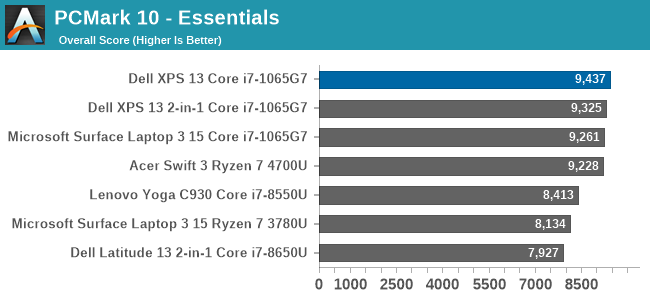
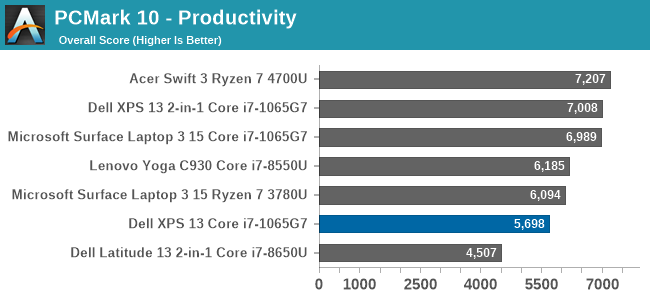
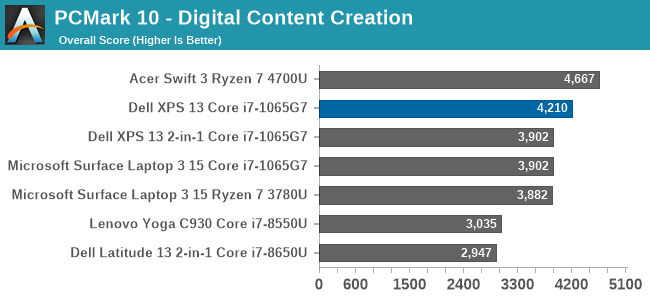
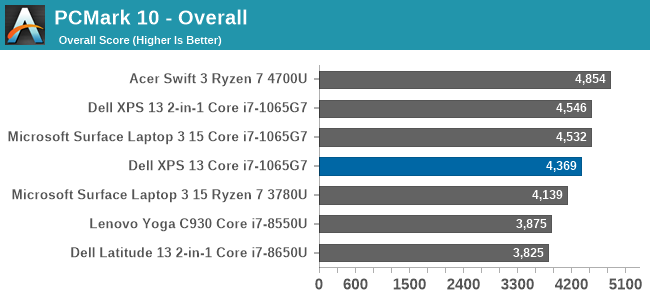
UL’s PCMark 10 is a whole-system benchmark, testing everything from CPU performance to app loading time. The Overall score consists of three categories, each featuring their own unique sub-tests. Overall the XPS 13 scored right in the same ballpark as other Ice Lake notebooks, although was slightly down in the Productivity tests, but slightly ahead in the other two.
Cinebench
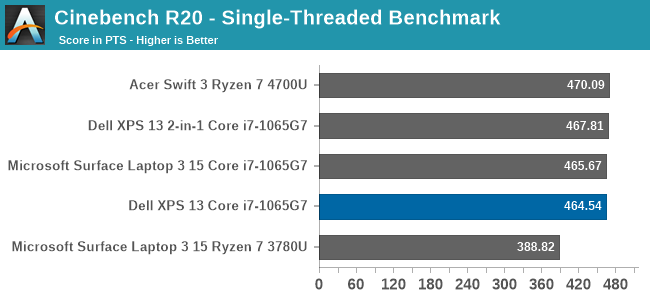
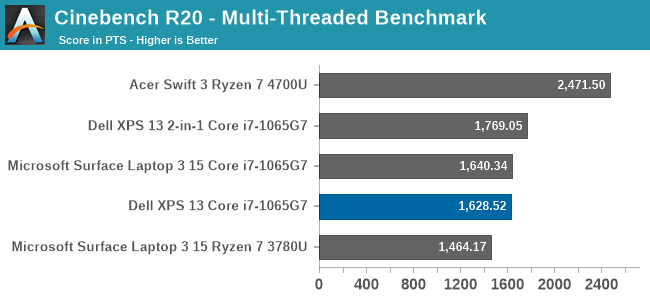
Cinebench, based on Maxon’s Cinema 4D rendering, allows tests of both single-threaded and multi-threaded runs, making it one of the more popular tests for overall computational performance. The XPS 13 does well compared to other Ice Lake equipped notebooks, although with AMD offering up to 8 cores in the same 15-Watt TDP, Intel falls behind in the multi-threaded run.
Handbrake
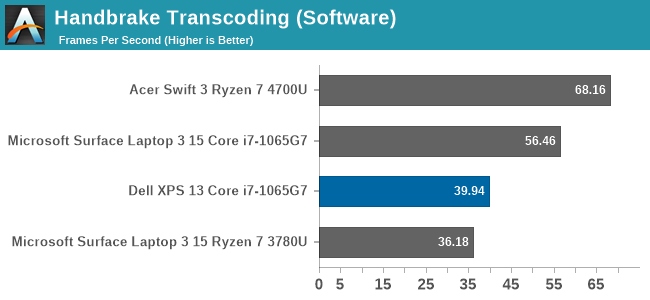
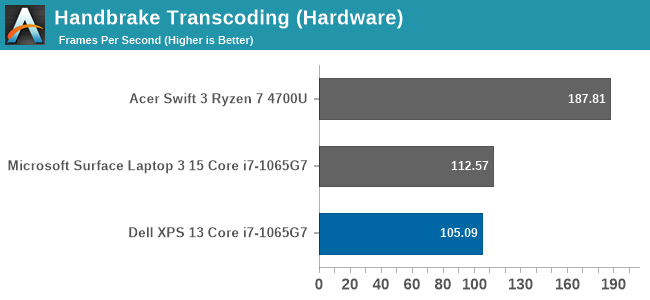
In our Handbrake encoding test, we transcode a 1080p movie to 720p using both software and hardware encoders. Software encoders utilize the CPU, and are generally the preferred method for optimal quality, whereas hardware encoders leverage the media blocks, which in this case is Intel’s QuickSync, for a much faster encode. As we will see more in the thermals section, Dell limits the XPS 13 to a 15-Watt TDP even in its maximum performance mode, where some other manufacturers will allow for higher than listed TDP, up to 20 Watts or so, and as such, the XPS 13 falls a bit behind other Ice Lake notebooks in this test which is TDP limited.
7-Zip


The popular file compression and decompression tool 7-Zip includes a built-in benchmark, and once again the XPS 13 slots right into where other Ice Lake notebooks fit.
Web Tests
Web performance is a function of not only the CPU performance, but also the browser’s scripting engine, and as such we have standardized on the Microsoft Edge browser. Microsoft has now transitioned their browser to the open-source Chromium project. Due to this, we have reset our web tests to use the new Chromium based Edge and taken the opportunity to decommission some of the older tests. We will now focus on Speedometer 2.0 and WebXPRT 3.
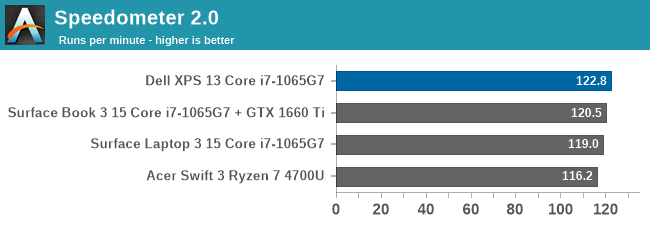
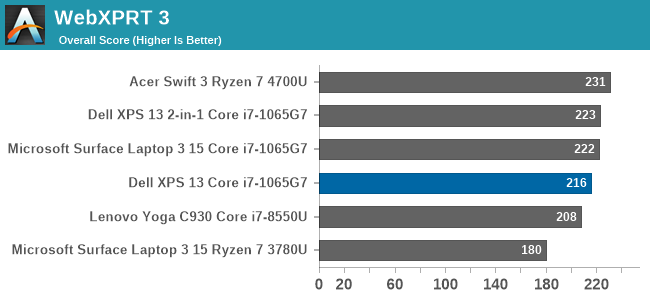
The XPS 13 again slots right in where you would expect for an i7-1065G7 based system.
Storage Performance
Dell offers from 256 GB to 2 TB of PCIe storage, and the review unit was outfitted with the Intel 600p 512 GB drive. We are transitioning to the PCMark 10 storage benchmark, which uses test traces of actual common workloads, such as booting Windows, and many of the Adobe applications, and as such should be a much better indicator of drive performance than just maximum transfer rates.
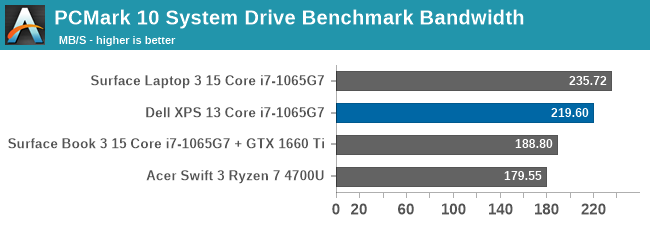
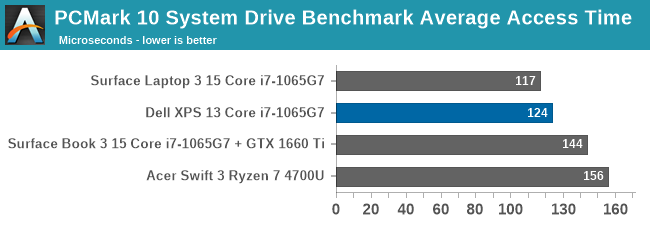

The Intel 600p performs quite well, with good access times and solid bandwidth. Surprisingly, it can’t quite match the excellent performance we saw from the SK Hynix 2230 form factor SSD in the Surface Laptop 3, but almost matches it.











224 Comments
View All Comments
grant3 - Friday, July 17, 2020 - link
USB-A is sometimes useful sure, but aside from old flash drives, what do you -need- it for?Just spend the $30 on some USB-C cables to replace your USB-A cables. Yes it's in many ways a needless expense, but it can be justified as a minor price bump for people who are already spending $1400+ on a new laptop.
yeeeeman - Thursday, July 16, 2020 - link
Tigerlake has a lot of things to fix...Sahrin - Thursday, July 16, 2020 - link
No Ryzen 4000 series; it's obsolete on launch day.roldaxc - Thursday, July 16, 2020 - link
Soldered SSD? only two Type-C ports? Just get an X1 Carbon. All around a much more solid laptop, more reliable, much better keyboard, lots of ports and similar footprint.I wonder why it's not included in the device comparison in this article..
iq100 - Thursday, July 16, 2020 - link
I would never buy a Dell product.When the XPS 15 9560 was purchased with on site service, it took six attempts to get it to work.
Here are the parts replaced on just the last (sixth) attempt.
SERVICE REPORT
REPLACEMENT PARTS
No. Dell Part QTY Description Parts Retained by Customer
1 5R1JP 1 ASSY,CVR,BTM,W/BDG,9550 No
2 M0T6P 1 ASSY,PLMRST,W/FPR,80,9560 No
3 9TXK7 1 ADPT,AC,130W,DLTA,4.5,L6,V2,E5 No
4 RN699 1 ADPT,CON,VID,DNGL,DP2VGA,L No
5 64TM0 1 ASSY,CBL,DC-IN, 9550/5510 No
6 2JVNJ 1 CORD,PWR,125V,2.5A,1M,C5,E5,US No
7 5G0HC 1 ASSY,PWA,DTRBD,AUDIO,9560/5520 No
Old wounds, not healed only fester. I purchase two U3011s. Both suffered the same design defect. Dell replace one but NOT the other, claiming "it was their policy to replace only one". Go figure.
www.tinyurl.com/HellIsDell
svan1971 - Thursday, July 16, 2020 - link
The only thing it's missing is a Ryzen cpu as far as I can tell.lmcd - Thursday, July 16, 2020 - link
Every comment thread is AMD vs Intel. I'm here to represent VIA's amazing Nano product line featuring Isaiah cores. Fight the power. Pick VIA.Honestly dunno why everyone is screaming for retroactive design wins. That's just not how it works.
Jorgp2 - Thursday, July 16, 2020 - link
Especially since AMD seems to count gaming laptops and their many products on the same chassis.What's the point of having more design wins, if those designs push fewer units.
Spunjji - Friday, July 17, 2020 - link
You should really ask the people making the designs. They're the ones shooting their own products in the foot, year after year.Spunjji - Friday, July 17, 2020 - link
Of course that's not how it works, but that's a straw man.According to the habitual Intel stans on this page:
You can't expect AMD designs when AMD has markedly inferior products and Intel is executing well.
You can't expect AMD designs when AMD have released broadly competitive products and Intel has been executing poorly for a couple of years with no signs of improving any time soon.
You can't expect AMD designs when AMD have released markedly superior products and Intel have been dropping the ball for 4 years straight but will maybe have a competitive product *soon*.
So the question is: when can we ever expect AMD designs to be developed? When do we finally get the competition needed to keep prices reasonable on high-end products?
The answer you're giving is "I'm fine with never", which means your opinion isn't worth shit.